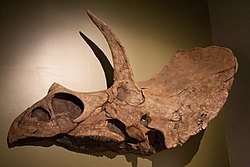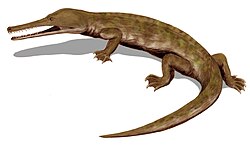Horseshoe Canyon Formation
Geological formation in Canada From Wikipedia, the free encyclopedia
The Horseshoe Canyon Formation is a stratigraphic unit of the Western Canada Sedimentary Basin in southwestern Alberta.[2][3] It takes its name from Horseshoe Canyon, an area of badlands near Drumheller.
| Horseshoe Canyon Formation | |
|---|---|
| Stratigraphic range: Campanian-Maastrichtian ~[1] | |
 Horseshoe Canyon Formation at Horsethief Canyon, near Drumheller. The dark bands are coal seams. | |
| Type | Geological formation |
| Unit of | Edmonton Group |
| Sub-units | Strathmore Member, Drumheller Member, Horsethief Member, Morrin Member, Tolman Member, Carbon Member, Whitemud Member |
| Underlies | Battle Formation, Scollard Formation |
| Overlies | Bearpaw Formation |
| Lithology | |
| Primary | Sandstone |
| Other | Shale, coal |
| Location | |
| Coordinates | 51°25′24″N 112°53′18″W |
| Region | Alberta Western Canadian Sedimentary Basin |
| Country | Canada |
| Type section | |
| Named for | Horseshoe Canyon |
| Named by | E.J.W. Irish, 1970 |
The Horseshoe Canyon Formation is part of the Edmonton Group. In its type section (Red Deer River Valley at Drumheller), it is ~250 metres (820 ft) thick, but further west the formation is older and thicker, exceeding 500 metres (1,600 ft) near Calgary.[4] It is of Late Cretaceous age, Campanian to early Maastrichtian stage (Edmontonian Land-Mammal Age), and is composed of mudstone, sandstone, carbonaceous shales, and coal seams. A variety of depositional environments are represented in the succession, including floodplains, estuarine channels, and coal swamps, which have yielded a diversity of fossil material. Tidally-influenced estuarine point bar deposits are easily recognizable as Inclined Heterolithic Stratification (IHS). Brackish-water trace fossil assemblages occur within these bar deposits and demonstrate periodic incursion of marine waters into the estuaries.
The Horseshoe Canyon Formation crops out extensively in the area around Drumheller, as well as farther north along the Red Deer River near Trochu and along the North Saskatchewan River in Edmonton.[2] It is overlain by the Battle and Scollard formations.[4] The Drumheller Coal Zone, located in the lower part of the Horseshoe Canyon Formation, was mined for sub-bituminous coal in the Drumheller area from 1911 to 1979, and the Atlas Coal Mine in Drumheller has been preserved as a National Historic Site.[5] In more recent times, the Horseshoe Canyon Formation has become a major target for coalbed methane (CBM) production.

Dinosaurs found in the Horseshoe Canyon Formation include Albertavenator, Albertosaurus, Anchiceratops, Anodontosaurus, Arrhinoceratops, Atrociraptor, Epichirostenotes, Edmontonia, Edmontosaurus, Hypacrosaurus, Ornithomimus, Pachyrhinosaurus, Parksosaurus, Saurolophus, and Struthiomimus. Other finds have included mammals such as Didelphodon coyi, non-dinosaur reptiles, amphibians, fish, marine and terrestrial invertebrates and plant fossils. Reptiles such as turtles and crocodilians are rare in the Horseshoe Canyon Formation, and this was thought to reflect the relatively cool climate which prevailed at the time. A study by Quinney et al. (2013) however, showed that the decline in turtle diversity, which was previously attributed to climate, coincided instead with changes in soil drainage conditions, and was limited by aridity, landscape instability, and migratory barriers.[6]
Oil/gas production
The Drumheller Coal Zone has been a primary coalbed methane target for industry. In the area between Bashaw and Rockyford, the Coal Zone lies at relatively shallow depths (about 300 metres) and is about 70 to 120 metres thick. It contains 10 to 20 metres of cumulative coal, in up to 20 or more individual thin seams interbedded with sandstone and shale, which combine to make an attractive multi-completion CBM drilling target. In total, it is estimated there are 14 trillion cubic metres (500 tcf) of gas in place in all the coal in Alberta.
Biostratigraphy
The timeline below follows work by David A. Eberth and Sandra L. Kamo published in 2019.[7]

Dinosaurs
Summarize
Perspective
Ornithischians
Ankylosaurs
| Ankylosaurs reported from the Horseshoe Canyon Formation | |||||
|---|---|---|---|---|---|
| Genus | Species | Stratigraphic position | Material | Notes | Images |
| [Five] skulls, mandibles, cervical vertebra, caudal vertebrae, dorsal vertebrae, sacrocaudal vertebrae, sacrum, illium, ischium, partial pelvis, coossified ribs, femur, ?manual phalanx, tail clubs, numerous cervical half-rings and osteoderms.[8][9] |
An ankylosaurine ankylosaurid also known from the middle Dinosaur Park Formation and closely related to Ankylosaurus.[10] |

| |||
|
E. longiceps[11] |
Upper Horsethief[11] |
A skull with mandible, dorsal vertebrae, dorsal vertebrae, sacral vertebrae, caudal vertebrae, cervical ribs, dorsal ribs, humerus, radius, ulna, radius, ilia, ischia, both pubes (?), femur, tibia, fibula and osteoderms.[11] |
A panoplosaurin nodosaurid also known from the lower Dinosaur Park Formation and closely related Denversaurus.[12] |

| |
|
E. tutus |
Walter Coombs (1971) synonymised Anodontosaurus lambei with E. tutus. However, recent studies suggest that Anodontosaurus is distinct enough from Euoplocephalus to be placed in its own genus and species.[8][13] Furthermore, all Horseshoe Canyon Formation ankylosaurine specimens were suggested to be reassigned to Anodontosaurus.[9] |

| |||
Hadrosaurs
| Hadrosaurs reported from the Horseshoe Canyon Formation | ||||||
|---|---|---|---|---|---|---|
| Genus | Species | Location | Stratigraphic position | Material | Notes | Images |
|
Horsethief; likely present in Drumheller. |
 | |||||
|
H. altispinus |
Morrin and Tolman. |
"[Five to ten] articulated skulls, some associated with postcrania, isolated skull elements, isolated postcranial elements, many individuals, embryo to adult."[14] |
 | |||
|
S. osborni |
Upper Morrin and Tolman. |
"Complete skull and skeleton, [two] complete skulls."[14] |
 | |||
Marginocephalians
Ceratopsians
Color key
|
Notes Uncertain or tentative taxa are in small text; |
| Ceratopsians reported from the Horseshoe Canyon Formation | ||||||
|---|---|---|---|---|---|---|
| Genus | Species | Stratigraphic position | Material | Notes | Images | |
|
Horsethief, Morrin, and Tolman; may have been present in Drumheller[16] |
[Two] nearly complete skulls and [seven] partial skulls.[16] |
A chasmosaurine ceratopsid contemporaneous and closely related to Arrhinoceratops.[16] |
 | |||
|
A. brachyops[17] |
Horsethief[17] |
A nearly complete skull.[17] |
A chasmosaurine ceratopsid restricted to the holotype specimen as Farke (2007) assigned the referred specimen ROM 1439 to Torosaurus.[18] |
 | ||
|
E. xerinsularis[19] |
Carbon[19] |
Premaxillae, maxillae, rostral, supraorbital horncore with lacrimal, prefrontal, frontal, postorbital, jugal, epijugal, quadratojugal, quadrate, partial parietal, squamosal frill, braincase, syncervical, cervical vertebrae, dorsal vertebrae, ribs and fragments of ossified ligaments.[19] |
A large chasmosaurine ceratopsid that may represent a senior synonym of Ojoceratops from the Ojo Alamo Formation.[20] |
 | ||
|
Upper Tolman[22] |
An isolated braincase.[22] |
A leptoceratopsid ceratopsian also known from the St. Mary River Formation.[21] |
 | |||
|
P. canadensis[23] |
Drumheller and Horsethief[23] |
[Two] partial skulls.[23] |
A centrosaurine ceratopsid also known from the St. Mary River Formation.[23] |
 | ||
Pachycephalosaurs
| Pachycephalosaurids reported from the Horseshoe Canyon Formation | ||||||
|---|---|---|---|---|---|---|
| Genus | Species | Location | Stratigraphic position | Material | Notes | Images |
|
S. edmontonense[25] |
Tolman[24] |
A pachycephalosaurine pachycephalosaurid also known from the Hell Creek and Kirtland Formation.[25] |
 | |||
Thescelosaurs
| Thescelosaurids reported from the Horseshoe Canyon Formation | ||||||
|---|---|---|---|---|---|---|
| Genus | Species | Location | Stratigraphic position | Material | Notes | Images |
|
P. warreni |
Tolman |
A partially articulated skeleton and partial skull. | A thescelosaurid neornithischian. |  | ||
Theropods
Maniraptorans
| Maniraptors reported from the Horseshoe Canyon Formation | ||||||
|---|---|---|---|---|---|---|
| Genus | Species | Stratigraphic position | Material | Notes | Images | |
|
A. curriei[26] |
Horsethief[26] |
[Two] frontals.[26] |
A troodontid theropod that adds to the diversity of North American troodontids.[26] |
|||
|
A. borealis[27] |
Upper Tolman[27] |
Ulna, tibiae, metatarsals, manual ungual, pedal phalanxes and unidentified pedal phalanges.[27] |
An mononykin alvarezsaurid specialized for digging insect nests.[27] |
 | ||
|
A. pennatus[28] |
Horsethief[28] |
A palatine, mandibles, ceratobranchials, axis, cervical vertebrae, dorsal vertebrae, pectoral girdles, sternal plate, forelimb, ilium, femur, tibia and fibula.[28] |
A caenagnathid oviraptorosaur recovered as sister taxon to Elmisaurus .[28] |
 | ||
|
A. marshalli[29] |
Lower Horsethief[29] |
Premaxillae, maxilla, dentaries, teeth and numerous bone fragments.[29] |
A dromaeosaurid; teeth indicate it may have been present across all members.[29] |
 | ||
|
E. curriei[30] |
Horsethief, Morrin, and Tolman[30] |
A maxilla, probable palatine, partial braincase, cervical vertebrae, dorsal vertebrae, caudal vertebrae, synsacrum, an anterior and a posterior cervical rib, a mid-dorsal rib, fragments of ilia, ischium, both pubes, partial tibia, and unidentifiable bones.[30] |
A caenagnathid oviraptorosaur known from material previously assigned to Chirostenotes.[30] |
 | ||
Ornithomimids
Color key
|
Notes Uncertain or tentative taxa are in small text; |
| Ornithomimids reported from the Horseshoe Canyon Formation | ||||||
|---|---|---|---|---|---|---|
| Genus | Species | Location | Stratigraphic position | Material | Notes | Images |
|
D. brevitertius |
Several specimens. type specimen |
An ornithomimid |
 | |||
|
O. currelli |
Junior synonym of O. edmontonicus |
|||||
|
O. edmontonicus |
Drumheller, Horsethief, Morrin, and Tolman |
Several specimens, type specimen |
An ornithomimid |
 | ||
|
S. altus |
Drumheller, Horsethief, and Morrin |
An ornithomimid |
 | |||
Tyrannosaurs
Color key
|
Notes Uncertain or tentative taxa are in small text; |
| Tyrannosaurids reported from the Horseshoe Canyon Formation | ||||||
|---|---|---|---|---|---|---|
| Genus | Species | Location | Stratigraphic position | Material | Notes | Images |
|
A. arctunguis |
Junior synonym of A. sarcophagus |
 | ||||
|
A. sarcophagus |
Horsethief, Morrin, and Tolman; likely present in Drumheller and Carbon. |
Several skeletons and partial skeletons, type specimen |
A tyrannosaurid which was the most common large carnivore in the area.[31][32] | |||
|
D. sp. |
Suggested from the skeleton of an immature tyrannosaurid (CMN 11315), thorough analysis of this specimen supports a referral to A. sarcophagus.[33] An isolated maxilla and teeth from an Edmontosaurus bonebed were also mistakenly referred to Daspletosaurus, however all the tyrannosaurid material in the bonebed was confirmed to belong to A. sarcophagus.[34] | |||||
Other animals
Summarize
Perspective
Mammals
Color key
|
Notes Uncertain or tentative taxa are in small text; |
| Mammals reported from the Horseshoe Canyon Formation | ||||||
|---|---|---|---|---|---|---|
| Genus | Species | Location | Stratigraphic position | Material | Notes | Images |
|
D. coyi |
 | |||||
Other reptiles
Color key
|
Notes Uncertain or tentative taxa are in small text; |
| Reptiles reported from the Horseshoe Canyon Formation | ||||||
|---|---|---|---|---|---|---|
| Genus | Species | Location | Stratigraphic position | Material | Notes | Images |
|
S. mccabei |
"a skull, partial lower jaws, and partial postcranial skeleton" |
An alligatoroid |
||||
|
C. albertensis |
"partial skeleton with partial skull" |
 | ||||
|
L. ultimus |
"a partial skeleton" |
a plesiosaur of uncertain classification |
||||
|
B. morrinensis |
"nearly complete shell" |
|||||
Fish
Color key
|
Notes Uncertain or tentative taxa are in small text; |
See also
References
Wikiwand - on
Seamless Wikipedia browsing. On steroids.



